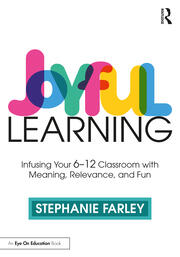Single Point Rubrics Are Efficient and Impactful
By Stephanie Farley
 It’s a truth universally acknowledged that in the same moment as a student hands you their completed assessment, they also ask, “So…what grade did I get?”
It’s a truth universally acknowledged that in the same moment as a student hands you their completed assessment, they also ask, “So…what grade did I get?”
While we teachers jokingly lament this phenomenon, we also recognize that students only ask us about their performance because they care. It’s a fantastic position to be in; of course students are going to ask, and of course we want to deliver the news as quickly as possible.
Enter the single point rubric, which is a minimalist, stripped-down version of the standard 4-point rubric. Here’s an example I wrote to guide professional development speakers, featuring my ideal criteria for PD content:
Professional Development Speakers
The major advantage of single point rubrics is immediately obvious: they are efficient yet impactful.
Descriptions: For the teacher, the efficiency is found in only having to come up with ONE description of competence for each of the criteria rather than 12 or 16 or 32.
I don’t know about you, but I’ve spent hours searching for the perfect words to distinguish between the “4” and “3” or “1” and “2” levels of performance. This is especially true for new assignments, as you don’t yet have the student work to show you the subtle differences between “complete novice” and “approaching proficiency.”
Happily, using a single point rubric means you only have to develop language for the “3” level, or “proficiency.” Consequently, you can write a single point rubric in just a few minutes because you already know how to describe proficiency in the targeted skills. In fact, you can dictate the words to Google speech-to-text and be done!
Grading: The other area of efficiency for teachers, of course, is in the time spent grading. Because you only have to write a few words on each rubric, pointing out particular strengths or offering recommendations, you can jam through your grading in a flash.
In my unscientific estimate, single point rubrics reduced my grading time by about 50%, as I didn’t feel the need to classify each suggestion as a “1,” “2,” or “3” level.
Simplified feedback fosters growth
Here are 3 ways the single point rubric can be used to aid students’ progress:
1. Ask students to evaluate each other’s work at a draft stage using the rubric. In this way, they get direct experience of applying the rubric language to the work product, and they subsequently feel more confident about what “proficiency” looks like.
2. The filled-out rubric is easy to scan and process. With a glance, students can see the actions they can take to improve the work and where their performance was excellent. Knowing exactly what to change means students can effectively implement those edits.
3. Finally, with just a few criteria on the rubric, students are much more willing to revise because they aren’t overwhelmed and demoralized by the volume of corrective feedback.
Both formative and summative assessment
Another helpful aspect of the single point rubric is that it can be used for both formative and summative assessment. It’s a quick way to let students know how they’re progressing as they practice, yet it’s also suitable for summative assessments.
I recently introduced the single point rubric to a teacher who wanted to evaluate multi-component projects that combined both traditional skills – like including evidence to support a thesis – and more creative skills, like inventing a game that builds connection between its players. The single point rubric was a perfect evaluative tool for this complex, highly engaging project.
Some things to keep in mind
As you fold a single point rubric into your grading practice, here are a few caveats:
►If you have an “everything, everywhere, all at once” approach to assessment, you may find it rewarding to let go of the idea that all areas of performance should be assessed at the same time. The single point rubric will be much more effective in fostering student growth when you focus on a few areas of competence.
In the example rubric, I only included 3 criteria for professional development. If I’d included more criteria – like how many jokes the presenter included or how well-timed the pauses and breaks were – it’s unlikely that the presenter could expertly deliver in each of the areas, simply because it would be asking for too much improvement all at once. It’s good to remember that learning is a repetitive process of tiny wins.
►Relatedly, while failure is an excellent teacher and persistence is super valuable, competence is the strongest motivator: it feels way better to see yourself getting good at a skill than it does to see yourself flail about and repeatedly miss the mark. Single point rubrics help students track their progress in a way that is motivating.
►Lastly, using a single point rubric means you don’t have to articulate levels of failure. Instead, you simply offer targeted suggestions for improvement. This really benefits students, as they don’t waste time fretting about how hard it is to move from a “1” to a “3” performance…they can just focus on implementing suggestions.
Credit where credit is due
Credit here goes to Jenn Gonzalez of Cult of Pedagogy, who wrote about single point rubrics back in 2014 and from whose blog post I learned about the technique. Around this time, I was struggling to figure out the quickest, most efficient way to get written feedback to my students on their summative assessments, and the single point rubric was the answer I needed. I’ve adapted her version slightly to align with my competency-based assessment lens.
A liberating tool, the single point rubric allows you to provide frequent, targeted feedback that is also timely. Further, in its easily digestible format, the rubric encourages measurable student growth. Wins all around!
Also see Stephanie’s post:
Creating Rubrics That Foster Student Growth

Stephanie’s first book, Joyful Learning: Tools to Infuse Your 6-12 Classroom with Meaning, Relevance, and Fun, will be published in April, 2023. She has created professional development for schools around reading and curriculum and coaches teachers in instruction, lesson planning, feedback, and assessment. Visit her website Joyful Learning and find her other MiddleWeb articles here.
































Neither of these systems of rubrics are good. You should write developmental rubrics where the criteria describes a learner performance.